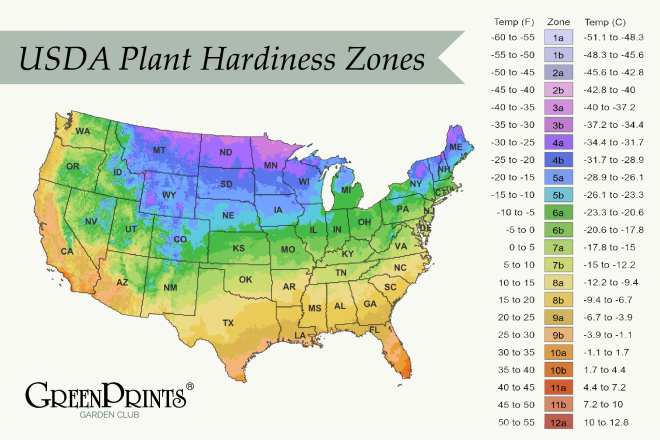
Rose gardening is a time-honored tradition, and the allure of these fragrant blossoms spans the diverse landscapes of the United States. However, not all roses thrive in every corner of the country. The concept of plant hardiness zones provides an essential guide for gardeners, helping them select the right roses that will flourish in their specific region. Learn the significance of plant hardiness zones in the context of rose gardening in the United States.

Understanding Plant Hardiness Zones:
The United States Department of Agriculture (USDA) developed the Plant Hardiness Zone Map to delineate geographic regions based on the average annual minimum Winter temperature. This map divides the country into zones, each representing a 10-degree Fahrenheit difference in the average minimum temperature. The higher the zone number, the milder the Winter temperatures in that region. For rose gardening, this map serves as a valuable tool to identify which varieties are best suited for a particular area.
Rose Varieties and Zone Compatibility:
Roses, with their vast array of species and hybrids, exhibit different levels of cold hardiness. Some roses are more resilient in harsh Winter conditions, while others thrive in milder climates. Understanding the plant hardiness zones is crucial when selecting rose varieties to ensure they can withstand the Winter temperatures in a specific region.
- Zones 1-4: Hardy Roses for Cold Winters: In the northernmost regions of the United States, where Winter temperatures can plummet well below freezing, gardeners should focus on cold-hardy rose varieties. Rugosa roses, with their tough constitution and vibrant blooms, are well-suited for these zones. Additionally, some shrub roses and hybrid teas developed for cold climates, such as the Canadian Explorer series, can withstand the challenging Winter conditions of Zones 1 to 4.
- Zones 5-7: Versatile Options for Moderate Winters: The central and northern parts of the country, including the Midwest and parts of the Northeast, fall into Zones 5 to 7. Gardeners in these regions have a broader range of options. Hybrid teas, floribundas, and grandifloras, known for their stunning blooms and diverse colors, can thrive in these moderately cold climates. Many popular modern rose varieties, such as the ‘Double Delight’ hybrid tea, flourish in these zones.
- Zones 8-10: Embracing Heat-Tolerant Roses: As we move southward, into the warmer climates of Zones 8 to 10, rose enthusiasts encounter a different set of considerations. Roses that can withstand higher temperatures and thrive in prolonged periods of heat become the go-to choices. Knock Out roses, known for their heat tolerance and disease resistance, are popular in these warmer zones. Floribundas and shrub roses with a reputation for heat resistance are also excellent choices for gardeners in the South.
Regional Nuances: Adapting to Local Conditions
While the USDA Plant Hardiness Zone Map provides a foundational guide for rose gardening, regional nuances and microclimates within zones must be considered. Factors such as elevation, proximity to bodies of water, and urban heat islands can influence local temperatures and impact the success of rose cultivation.
- Mountainous Regions: In mountainous areas, especially in the western United States, elevation can drastically affect temperatures. Even within a single hardiness zone, gardeners may need to select roses that can endure colder conditions prevalent at higher altitudes. Hardy landscape roses and cold-resistant hybrids are often recommended for these challenging environments.
- Coastal Climates: Coastal regions, with their milder temperatures and higher humidity levels, offer unique growing conditions. Gardeners in coastal areas may find success with a broader range of rose varieties, including those that might struggle in hotter inland climates. The moderating effect of the ocean can create favorable conditions for hybrid teas and other less cold-resistant varieties.
Climate Change and Adaptation:
As climate patterns evolve, rose gardening enthusiasts must also adapt their approach. Climate change brings about shifts in temperature and precipitation patterns, impacting the traditional hardiness zones. It’s essential for gardeners to stay informed about changing climate conditions and choose rose varieties that align with the evolving environmental dynamics.
Rose gardening is a journey of beauty, fragrance, and connection to nature. Understanding the plant hardiness zones in the United States is a fundamental step toward cultivating a successful and thriving rose garden. By selecting varieties that align with the specific climate conditions of each region, gardeners can ensure the health and vitality of their roses, creating stunning displays of color and fragrance that are well-suited to the unique characteristics of their local environment. Whether in the frosty landscapes of the North, the temperate zones of the Midwest, or the sun-drenched gardens of the South, the beauty of rose gardening unfolds within the borders of plant hardiness zones, creating a tapestry of blossoms that truly flourishes across the diverse landscapes of the United States.
Check out the USDA Plant Hardiness Zone Map and find out what zone your zip code is located in here. Or you can use our map to get a general idea of what your plant hardiness zone is.




